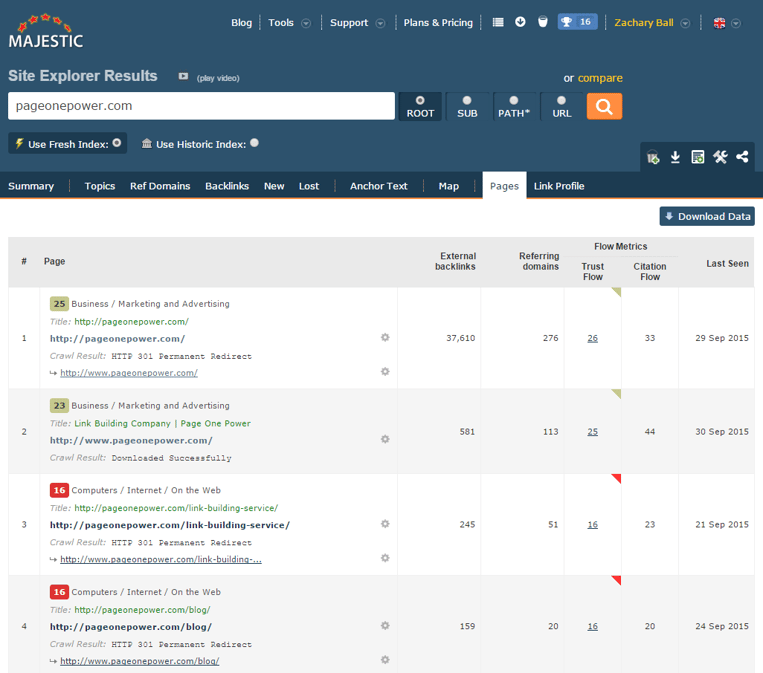Enterprise clients present unique challenges and opportunities in link acquisition due to their size, brand equity, and bureaucracy.
There are more factors to account for in an enterprise-level campaign, as you’re working at a different scale than with a small to medium sized business.
Distinct factors in link campaigns for Fortune 500 companies include:
- Hyper-competitive marketplaces
- Established, well-known brand names
- Sheer size of websites
- Scope of projects – enterprise businesses require long-term solutions
- Corporate hierarchy and bureaucracy
- Diverse set of ongoing marketing strategies
- Large budget, planned well in advance
Of course, every link campaign is different and requires a customized strategy. But in general there are specific link acquisition tactics that work particularly well for large brands.

So, given all these factors, how do you build links for enterprise clients that will move the needle? Here are five tactics especially successful for enterprise clients:
- Mention monitoring
- 404 link reclamation
- Content promotion
- Community engagement
- Competitor analysis.
I’ll explain why each these five tactics are effective for enterprise-level companies.
1. Mention Monitoring
One of the most efficient ways to earn links for large brands is through monitoring web mentions.
Because major corporations have established brands, there are increased link opportunities. Well-known brands are simply talked about more online because they’ve built brand awareness, which leads to more mentions and thus more link opportunities.
Finding mentions is only half of the link acquisition equation. To successfully secure links you will need quality outreach. Every situation will require different, personalized outreach – just remember to be polite and build positive relationships and chances are you’ll get some great links.
There are a few different options when it comes to tools to locate mentions.
My favorite paid tools are Mention and Fresh Web Explorer (from Moz).

Google Alerts is a great free option. However, Google Alerts will miss a large portion of mentions, so it’s worth investing into a paid tool to catch everything.
Branded mentions tend to be the most fruitful in terms of link acquisition, since the site has already mentioned your client by name so a link is much more relevant, but there’s no reason to limit mention monitoring to branded terms only. There are also unbranded terms that could turn up mentions that lead to links. Potential unbranded mentions include:
- Prominent employees
- Company-specific products/services
- Corporate programs or charities
- A term closely tied to the brand.
Images can be equally useful in link acquisition. Like mentions, everywhere the client’s proprietary images are used around the web creates link opportunities. Citation links to cite the source of the image is accepted practice, and a polite request is often all that is needed to secure a link.
Great tools for finding where your images are being used on the web:
All three tools are free and you can learn more about how each works here.
Different types of images worth monitoring in order to secure links:
- Logos – new and old
- Corporate buildings
- Employee headshots
- Company events
- Branded products
- Etc.
Monitoring mentions and images can be very effective for enterprise link acquisition as big brands tend to be referenced frequently across the web.
2. 404 Link Reclamation
Another great tactic for earning links to large businesses is 404 link reclamation.
Large enterprise-level websites are typically older, well-established sites that have evolved to stay current with web trends. Because these websites have been around for a long time, chances are good they have some links pointing to pages that no longer exist, creating a 404 error.
On-site 404s offer excellent link prospects as well as opportunities to build relationships. By finding links pointing to 404s you find wasted link equity on your site. Simply contact the site that’s linking and direct them to a proper, functional URL, thereby restoring the proper flow of link equity. This process--which is often referred to as link reclamation—can lead to fresh links and positive relationships with webmasters by fixing the link on their site.
Of course, it’s also worth noting that simply creating a 301 redirect to the working URL can be easier in situations where it might be difficult to contact the linking site.
Some of the best tools for finding 404s include:
Check out this great tutorial from Cory Collins to learn more about 404 link reclamation. Beam Us Up in particular is nice because it’s free, and Nicholas Chimonas wrote this tutorial specifically on how to use the tool.
3. Content Promotion
Content promotion should be a staple within any link campaign, but is especially effective for large, corporate clients.
This is because enterprise clients typically have the budget to invest into content, and thus have a content marketing initiative in place or have previously invested into creating compelling content for their audience.
For example, enterprise clients will often have as part of a content strategy:
- Audience resource creation
- Regular blog posts and articles
- Individual placements/guest posting
- Regular columns on industry sites
- Infographic/image creation
- Video content
- Etc.
Creating content their audience values will naturally generate link opportunities, making it important to integrate with other marketing efforts as an SEO. Content marketing and link building have a synergetic relationship and should go hand-in-hand. As my boss Jon Ball said, “Content marketing without marketing is just content”, and link building should be that marketing.
Link builders should be involved in content strategy, not just promotion. It’s certainly possible to promote content for links after it’s created, but it’s much easier to earn links if an SEO guides the ideation process by providing insight into aspects like:
- Audience interests and pain points
- Important and popular niche topics
- Past successful content
- Potential linking websites
- Content gaps
- Etc.
Effective enterprise link acquisition should integrate and communicate with other marketing efforts, but the most efficient, seamless link campaign will feature content created with links in mind.
4. Community Engagement
Community engagement is another great method to secure links for big brand clients.

Enterprise-level companies typically have many irons in the fire when it comes to communities. To maintain prominent market position large brands must continuously work to stay in front of their massive audiences.
There are many different community events enterprise clients will naturally be involved in that can be leveraged for links. Some prime examples include:
- Partnerships
- Associations
- Sponsorships
- Interviews
- Events
- Charities
- Scholarships
- Industry round-ups
- HARO
- Contests/giveaways
- Etc.
There are a plethora of link opportunities baked into the existing community engagement strategies enterprise businesses already implement, so approaching these activities with a link mindset can propel an SEO campaign. This is a key difference between mentions and community engagement, because mentions have already happened and links are earned afterward. But with community engagement tactics, link builders can work with the departments executing them as the strategies are carried out.
Leveraging these opportunities for links provides added value to existing initiatives and furthers important community connections. Furthermore, these links offer more than strictly SEO value as they support brand and reputation building.
5. Competitor Analysis
Keeping an eye on the competition is always a good idea, but competitor analysis is especially useful for enterprise link building.
Major corporations operate within ultra-competitive markets, so competitor analysis is a vital piece of a successful enterprise link campaign. Effective competitor analysis will involve many of the strategies discussed earlier in this post, but with regards to the client’s competitors.
For instance, just as client mentions present link opportunities so do competitor mentions. Because competitors share a similar audience to the client, monitoring competitor mentions will reveal relevant link prospects for your link project, and the same goes for image searching.
Finding 404 pages on competitor sites can present link opportunities as well. The process is essentially the same as link reclamation for a client’s site except during outreach you suggest replacing a competitor’s 404 page with a similar page on your client’s site.
While backlinking the competition it’s worth examining their top performing pages as well.

(Screenshot of a Majestic report of Page One Power's top linked pages)
Analyzing which types of pages are popular and why can help guide your content promotion strategy. Using Brian Dean’s skyscraper technique will lead to great link opportunities that can help an enterprise company outpace their competition in search.
More importantly, competitive analysis can help guide your own link strategy. You’ll be able to see what’s worked within the industry for your competitors, and what has failed. This will give you key insight into the industry’s linking environment, influential sites worth considering, and more. Competitive analysis is a key piece of any campaign research, and should be used to determine campaign strategy.

